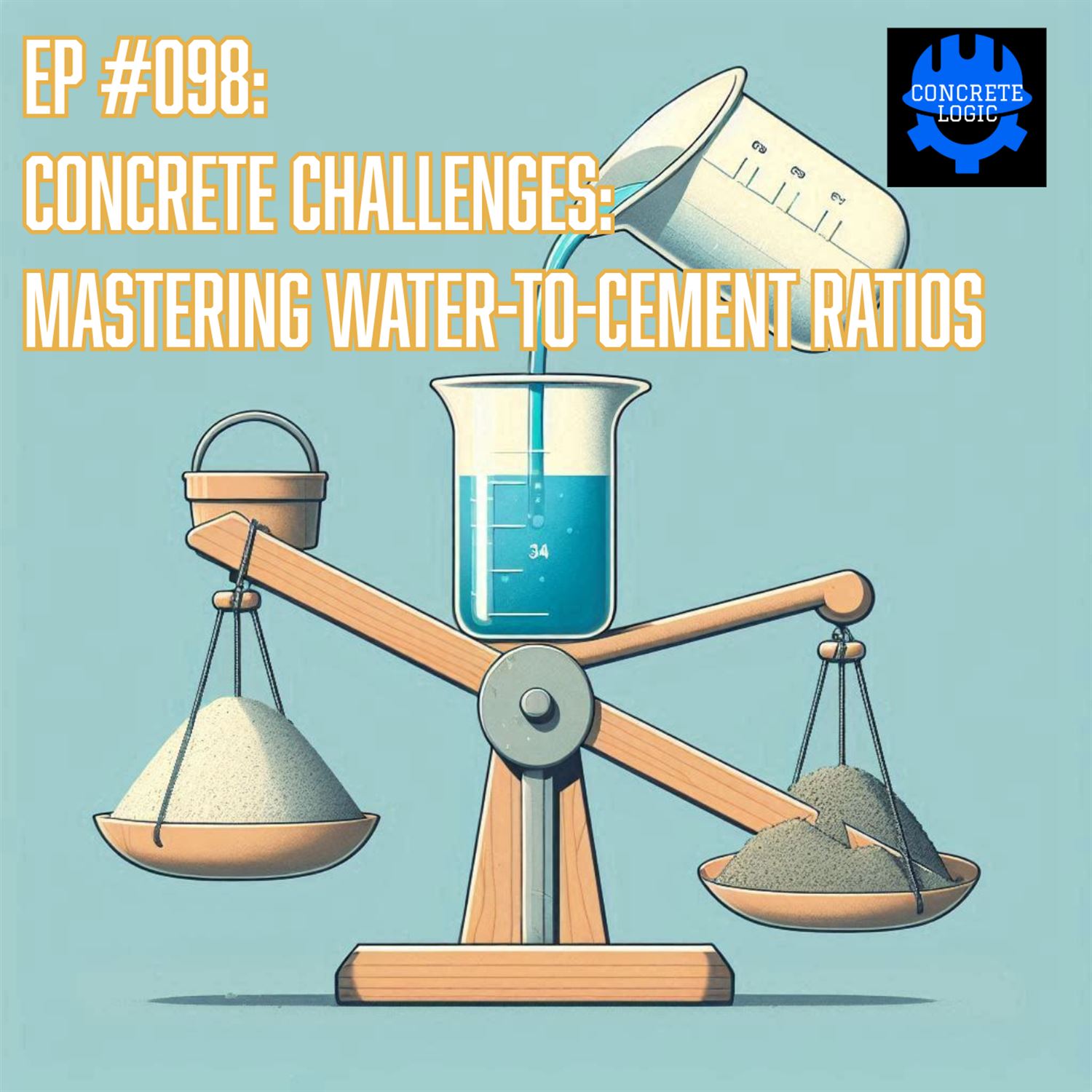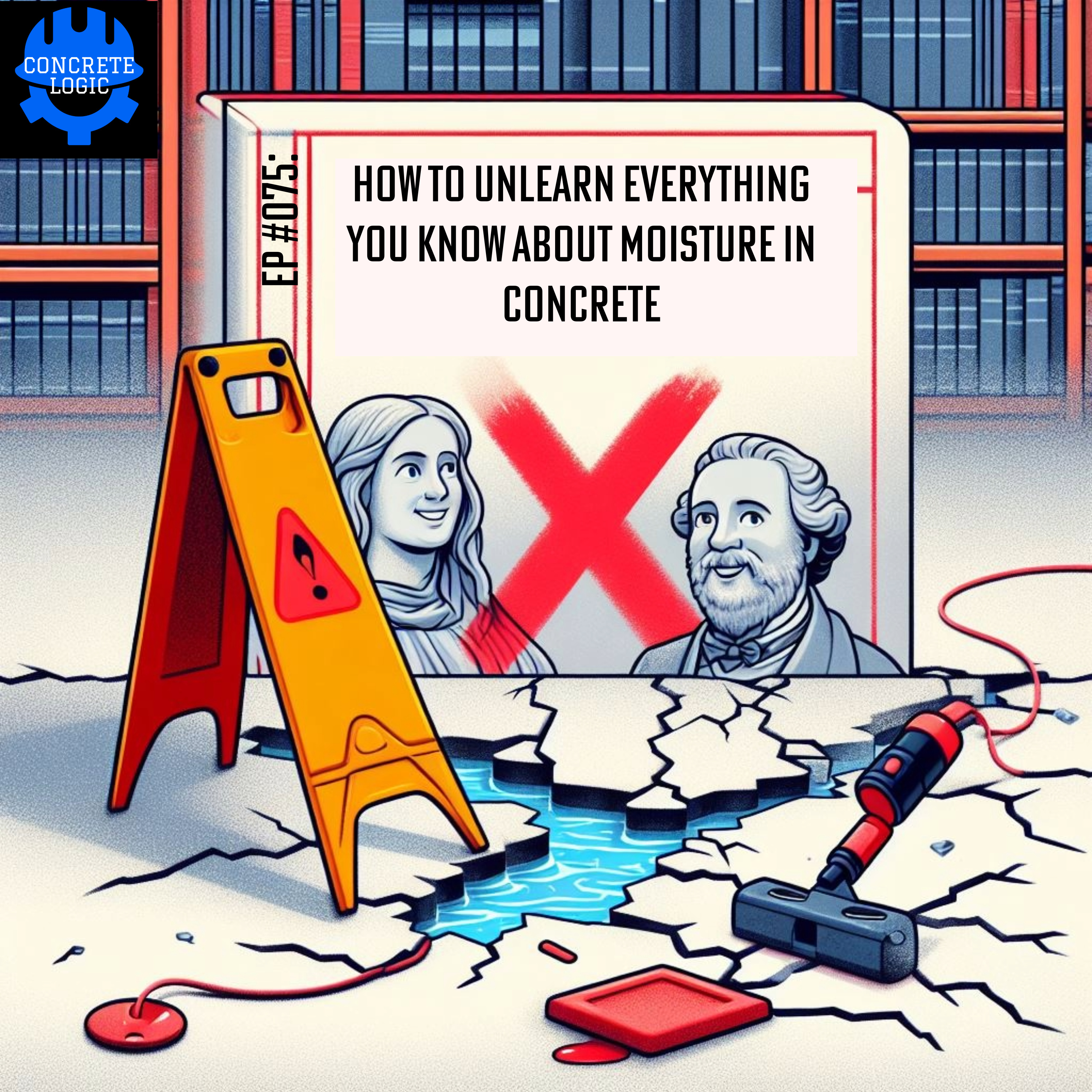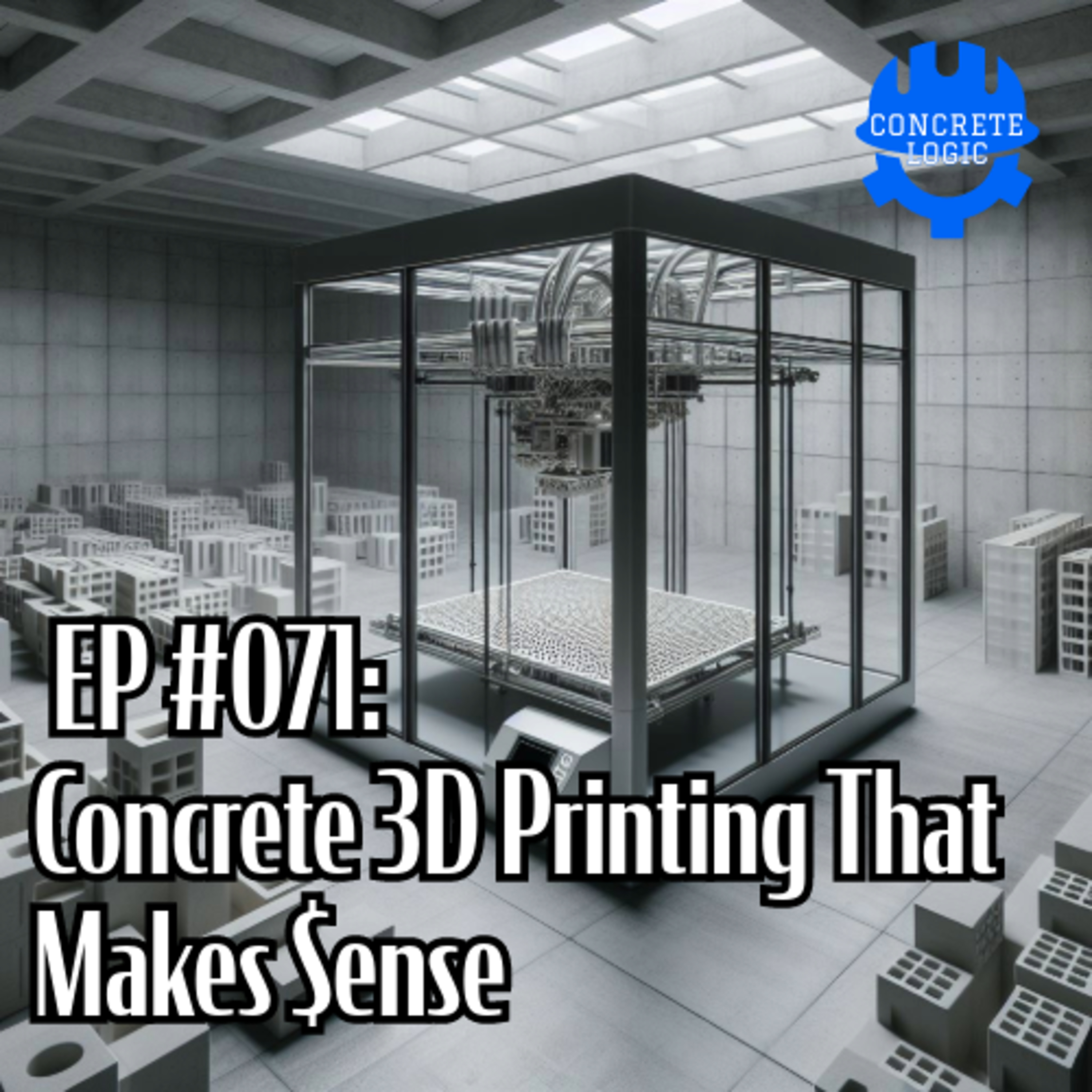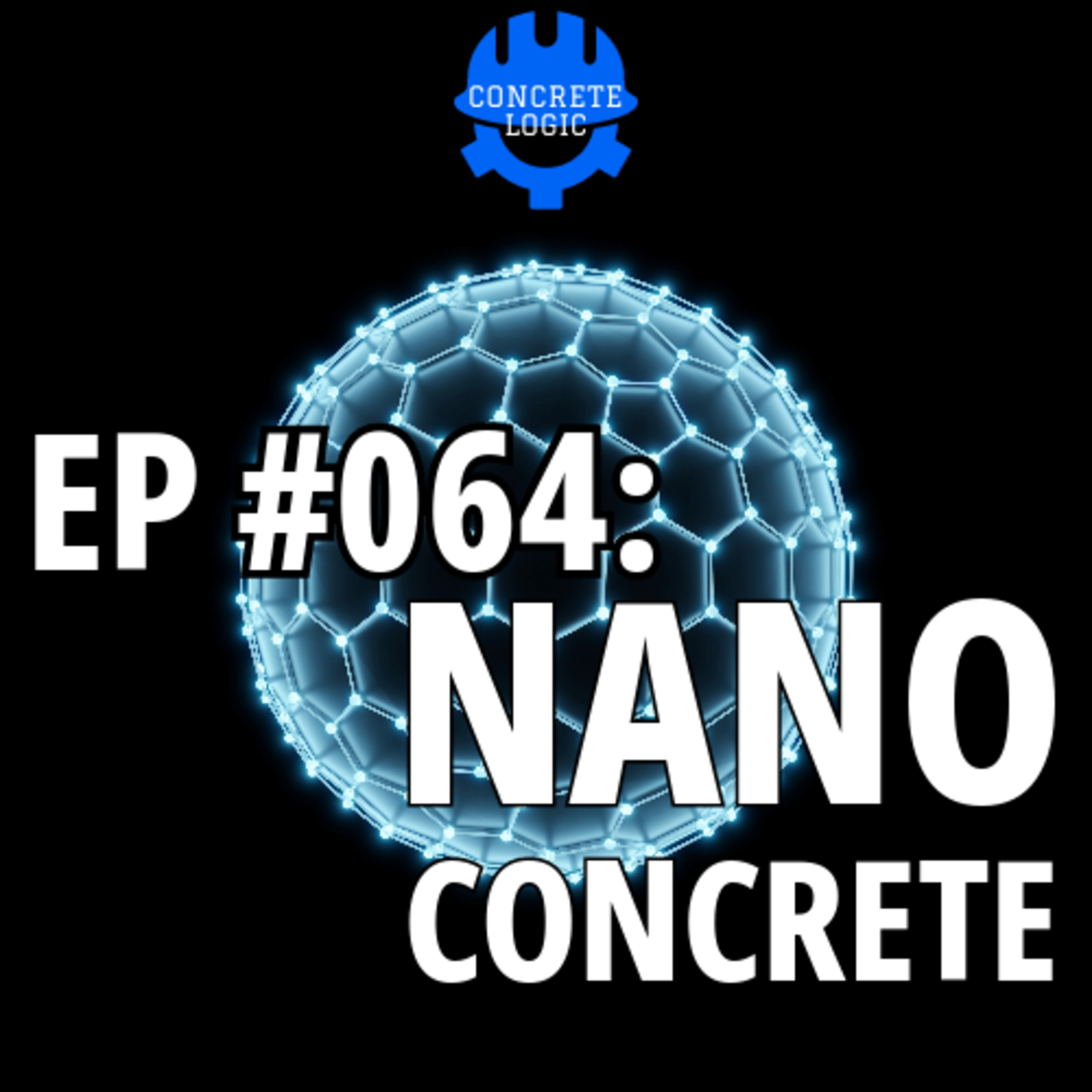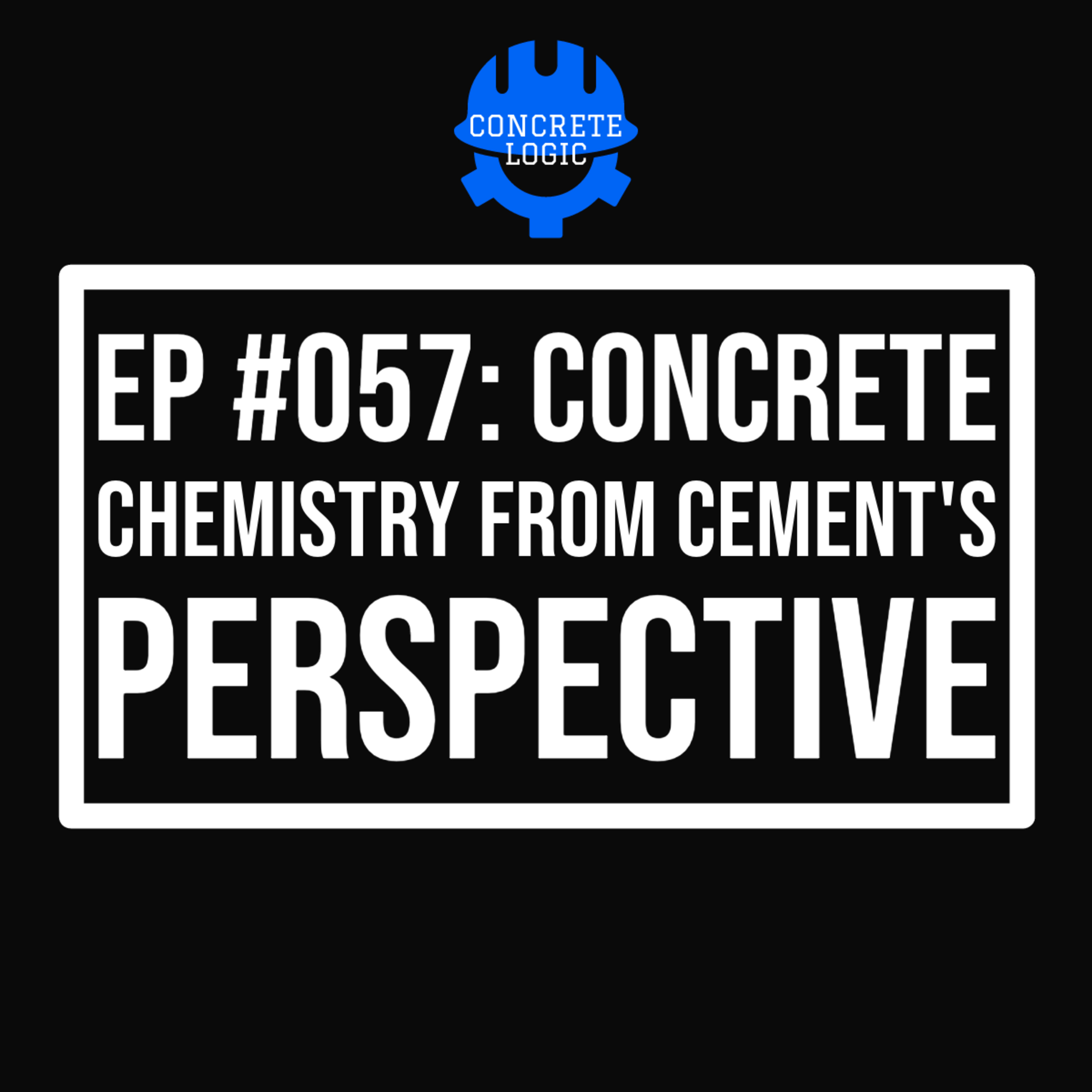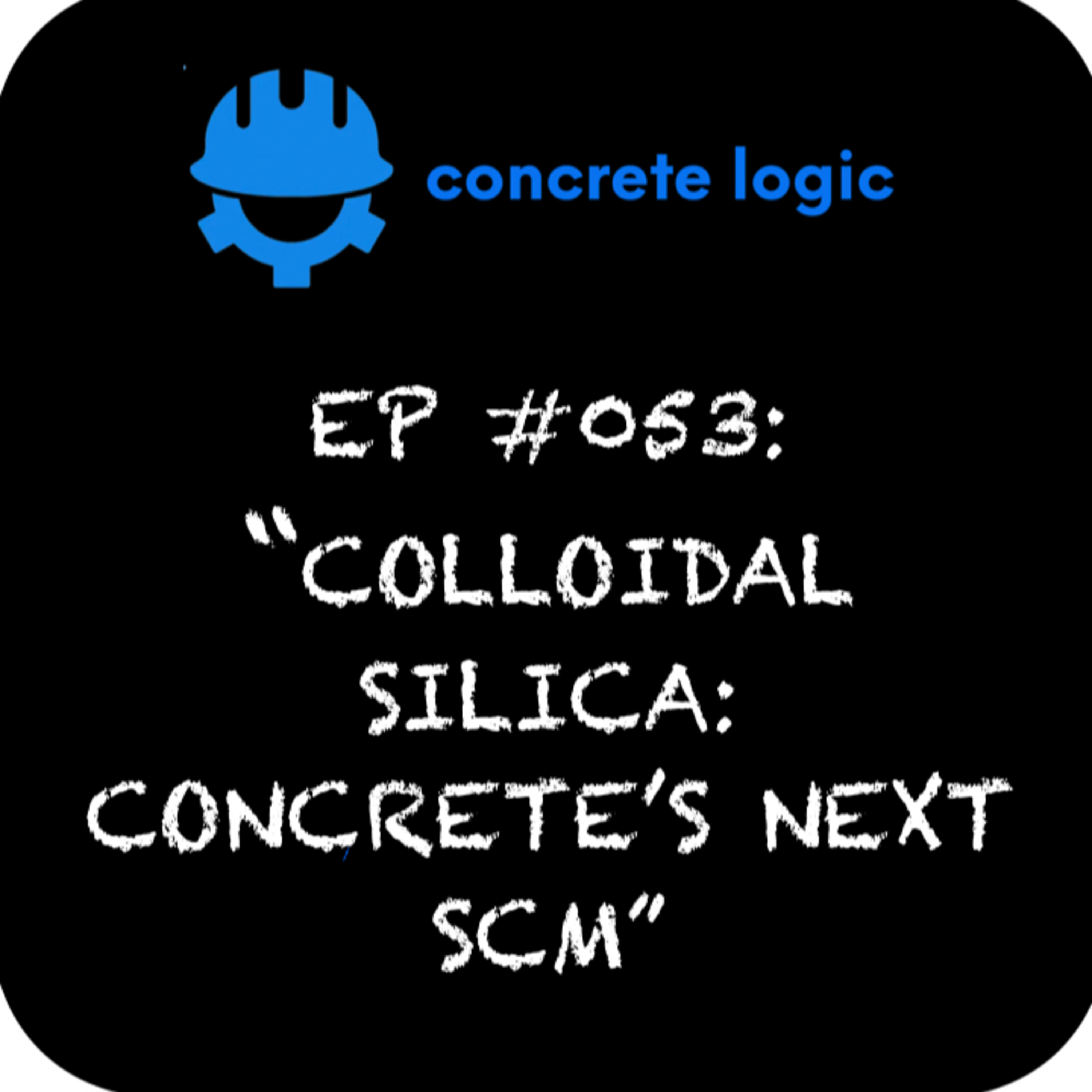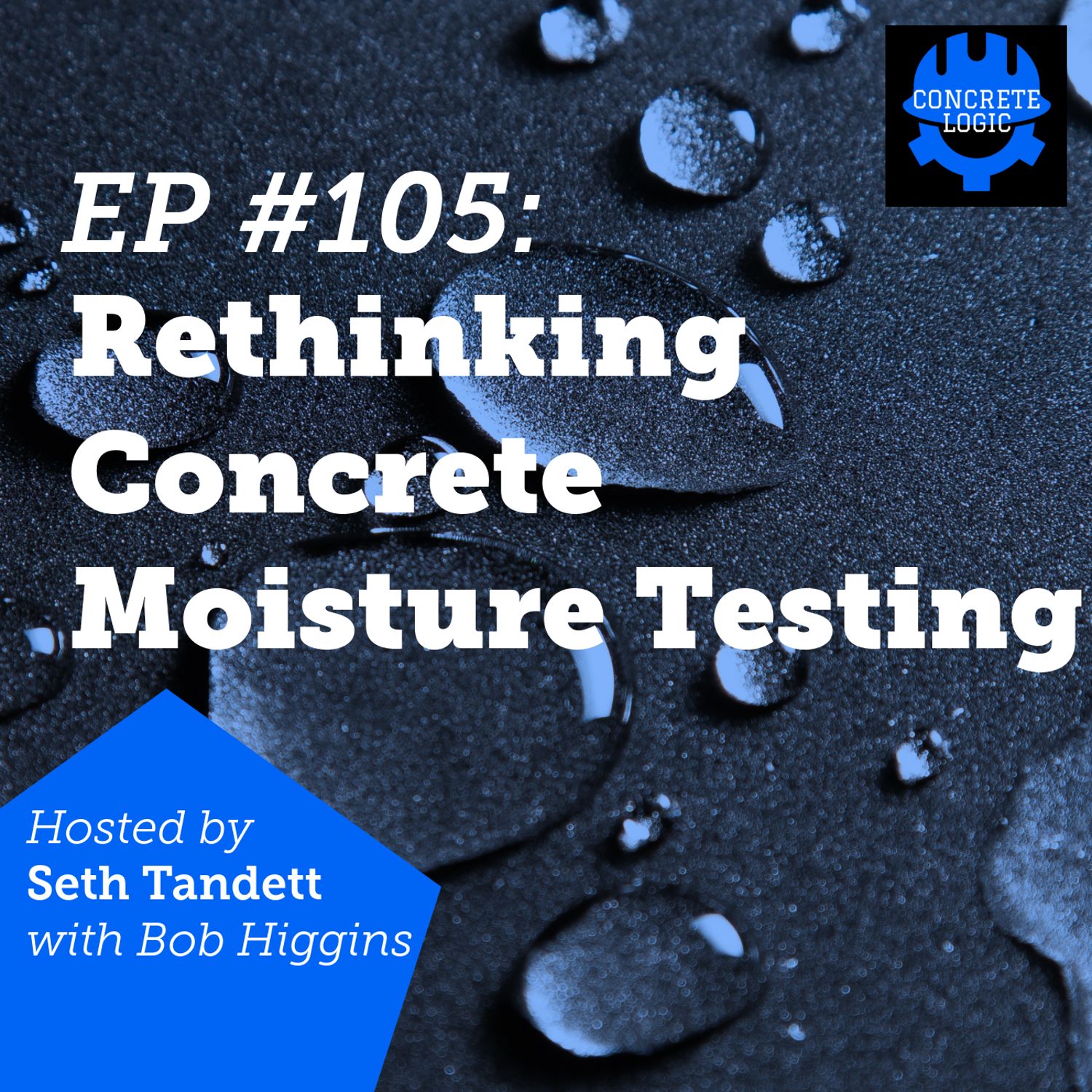
EP #105: Rethinking Concrete Moisture Testing

In this episode of the Concrete Logic Podcast, Seth and Bob Higgins discuss the complexities of moisture testing in concrete. They explore the misconceptions surrounding moisture dynamics, the importance of time of installation testing, and the regional variations in moisture standards. Bob emphasizes the need for better moisture data interpretation and environmental factors impact on concrete performance.
Takeaways
• Moisture testing in concrete is often misinterpreted.
• Older concrete can have more moisture-related issues than newer concrete.
• Timing of installation testing is crucial to avoid moisture claims.
• Concrete's top inch is often weaker and more permeable.
• Environmental control is essential during concrete installation.
• Salts in concrete can attract moisture from the air.
• Regional differences affect moisture standards and testing.
• Understanding building science can prevent costly mistakes.
• The stack effect can influence moisture levels in multi-story buildings.
• New concrete formulations may have increased alkalinity, leading to more issues.
Chapters
00:00 Rethinking Moisture Testing in Concrete
10:48 Understanding Concrete's Moisture Dynamics
15:29 Time of Installation Testing
18:44 Internal vs External Concrete Issues
20:55 Regional Variations in Moisture Standards
22:33 Balancing Water in Concrete Mixes
25:32 The Future of Concrete Materials
***
Did you learn something from this episode? Would you like to support the concrete industry's favorite podcast?
If so, donate at https://www.concretelogicpodcast.com/support/ .
When YOU donate to the show, you will be listed as a producer of the next episode that is released!
Elevate your expertise in concrete construction by joining the Concrete Logic Academy! You can try it for one week for free, and you can cancel at any time.
Learn more at https://www.concretelogicacademy.com
***
Episode References
Guest: Robert “Concrete Bob” Higgins | RC Consulting | rcconsulting.higgins@gmail.com
Guest Website: https://www.concretelogicpodcast.com/guests/robert-higgins/
Producers: Jodi Tandett
Do you want your name or company listed on the next episode? Find out how: https://www.concretelogicpodcast.com/support/
Music: Mike Dunton | https://www.mikeduntonmusic.com | mikeduntonmusic@gmail.com | Instagram @Mike_Dunton
Host: Seth Tandett, seth@concretelogicpodcast.com
Host LinkedIn: https://www.linkedin.com/in/seth-tandett/
Website: https://www.concretelogicpodcast.com/
LinkedIn: https://www.linkedin.com/company/concrete-logic-podcast
JOIN THE COMMUNITY DEDICATED TO CONCRETE!
CONCRETE LOGIC ACADEMY: https://www.concretelogicacademy.com/
Seth (00:01.301)
Welcome to another episode of the Concrete Logic Podcast. And today I have Bob Higgins, Concrete Bob, back on the show. I always enjoy having Bob on the show. I learn a lot from him and you will too. We're going to talk about re-thinking moisture testing today. But before I get started, just to remind you, you can support the podcast in three ways. One is when you...
Bob Higgins (00:09.868)
You
Seth (00:28.681)
After you listen to this podcast and you, and you, learn something from it. want you to share the podcast with someone, a coworker colleague. and it don't be selfish with what you learned today. the second thing is, go to concrete logic podcast.com. there are two ways that you can get ahold of me. There's a contact link on the top of the page. You click on that contact link and that's like shooting me an email or you can.
click on the microphone that's in the bottom right hand corner of the homepage. And that's like leaving me a voicemail. And I'm looking for two things. I'm looking for topic suggestions or guest suggestions. Because I want to put out the podcast episodes that you want to hear and who you want to hear from. So that's important. And then the last thing you can do is if you feel like you got some value out of this, if you learned something from Bob today and you believe it's...
has a monetary value to it, then feel free to click the donate button that's on the Concrete Logic Podcast homepage and you can give any amount and any amount is appreciated. With that, Bob, that's the quickest intro I've done yet. I only have you for 30 minutes. So I want to make sure we get all we can out of you today. So Bob,
Bob Higgins (01:46.68)
you
Seth (01:56.917)
We were talking quite a bit before I hit record. We want to talk about rethinking moisture testing in concrete. Where do you want to start?
Bob Higgins (02:10.222)
I'm really glad you asked that because I'm going to be teaching a building sciences class up in Jacksonville, Florida on November 12th. And I'm going to be covering some basics because we keep going round and round with the different people about how to moisture test and what's wrong, what's right with it. And what really bothers me is everybody involved
Selling something that's a moisture test is always finding fault with somebody else's Moisture test they all they're all pretty accurate the problem we're having is people do not know how to interpret the data properly and so what I'm going to do rather than jump into the heavy science of this what I'm going to do is give a couple of examples that we were talking about earlier I taught a class last year up in San Leandro
to a union group of installers. And as I was finishing up, they asked me a question. said, why is it that older concrete is drier, but we appear to have more problems with older concrete than we do newer concrete? And I started to explain that older concrete tends to collect salts underneath the finish or the coating or whatever else is on the concrete.
and it will store that up. But what happens is somewhat inert because there's really no moisture source. Because I said there's this mistaken belief that moisture moves from the cooler underside to the warmer top side of the concrete. It doesn't work that way. But through diffusion, the salts will work their way up because the salts tend to become more active with warmer temperatures. So there's this gradual movement of salts towards the surface. Then once you open up the concrete,
Now these salts have a new moisture source, the air. So they'll start gulping moisture from the air. And they were kind of surprised by that. And they said, well, that makes sense. But they were reluctant to adopt it because it completely contrary to what they've been taught. I said, I know it's contrary. But basically, you're going to find out as you start jumping into this, we'll work back and forth. And I'll of help you through some of these moisture tests and the interpretation.
Bob Higgins (04:31.064)
over time. And so what happened then is this moisture meter company went in three months later to show them how to use their moisture meters. And it was on a 40, 42 year old warehouse concrete. So they tested the moisture meter was 1.9%. They ground off the curing compound, they tested it again as 1.9 % moisture. Well, they left and it came back.
Somewhat they weren't exactly certain what the time element was but they said it was only between 10 and 15 minutes They came back and when they put the meter back down and jump to 4.3 percent Well, everybody was shocked. So they got me on the phone I said I'm surprised it picked up and we sure that quickly but that's an object lesson I said one of the things that people don't understand is when you're dealing with a mineral based product And concrete is full of minerals. It's full of water loving materials
that will attract water. It will hit dew point well before atmospheric dew point. Everybody's so focused on dew point. But we have elements in the concrete that have dew point issues where it's much lower than 100%. And I often use the calibration solution of sodium chloride, which is the same thing as table salt. If you put sodium chloride out in the air,
As long as the relative humidity is less than 75%, it stays dry. But as soon as the humidity rises much above 75%, it eliquifies, it condenses. Well, that's its dew point. That's called ionic dew point. That is present in all concrete. So that's why I tell people, said, we need that buffer of a 10 degrees Fahrenheit difference between the concrete and dew point. If you don't have at least that.
amount of a buffer, you're going to have concrete that's actively absorbing moisture. So when you go to test it, it's picking up moisture from the air, and people mistakenly, like they would have with that warehouse, if they hadn't tested right away, and then shortly after, and they tested the next day like is normal for standard practice, they would have thought, well, look at all the moisture in the concrete. That was not moisture in the concrete, it came from the air.
Bob Higgins (06:55.264)
So it is time of installation testing that is so critical here. And as I've worked with the different installers where they've started doing time of installation testing, they've almost completely gotten rid of any of moisture claims because they're catching these issues as they come up. Because if somebody, for example, very seldom will you ever find concrete that's as warm as the air. It's almost always colder. Water moves from warm to cool.
I keep telling people that so pay attention to that so some summer day and somebody opens up the door and warm air blows in you're gonna get a burst of Air that contains a lot of water because the warmer the air the more Moisture it holds and all of a sudden it finds this cool concrete it settles in soaks it so you can actually have a Moisture issue introduced at time of installation and this happens a lot
Seth (07:52.329)
Yeah. That's like a glass of ice water, right? The water beads on the outside. The water's not going through the glass.
Bob Higgins (07:57.357)
Yes.
Bob Higgins (08:01.624)
Exactly and it's not going through the concrete either because one of the things that we found and announcement confirmed over and over again is Standard concrete as we know it cannot be cured properly to where you get a surface that's as dense and as Has the same compressive value as the remainder of the concrete so it is the top inch of the concrete that's that's really the issue That came up again. Well, I have a
Seth (08:04.746)
Yeah.
Bob Higgins (08:31.96)
like that illustration I sent you where they were doing basically this ARRI's probe test and it was in a laboratory setting and it bothers me that concrete consultants saw that and didn't give it any regard at all. But in that study, it showed that the relative humidity towards the top inch of the concrete was reduced to 74%. Once...
The relative humidity of concrete drops below 80 % cement formation stops. And the longer that goes, the less recoverable that is. So you have permanently damaged concrete surface. It's now more permeable and absorbs a lot more water and is weaker. So that's what's picking up the moisture from the air. But we're being re-
But everybody regards the concrete as being this monolithic uniform sponge. That's not the way it is at all.
Seth (09:34.261)
Yeah. And this goes for new concrete too. mean, your, your examples are old concrete and existing facilities that they're redoing and, but the same goes to, for like a new floor, right? New concrete floor.
Bob Higgins (09:51.288)
Yeah, and it's probably worse than it was back then because since 2002 to 2018, the EPA required all the cement producers to reincorporate some of the flue gases back into the cement process. It's called cement kiln dust, and that's more alkaline. So they've introduced more alkalinity than we had in the past. Now it's to the point where the ACI and the ASCC, the American Society of Concrete Contractors,
have basically informed engineers and specifiers that curling and cracking is to be expected. It's not unusual and they can go according to all the standard practices and this is still going to happen. That didn't happen in 1950s concrete. You can get that kind of curling and cracking. But we're being retaught and reconditioned to regard that as being normal.
Seth (10:40.139)
Yeah.
Bob Higgins (10:48.264)
And so I like what the Texas Transportation Institute did where they took the concrete, they water cured the concrete, they did one air cure and then one water cure. Well, the water cure was seven day water cure. But what they did different is they sliced off the top one inch. So even with a seven day water cure, the top inch of the concrete was a full 20 % lower in compressive value than the remainder of the concrete.
So even under a close laboratory condition, the surface is still weaker. Now that collaborates and corroborates the relative humidity study that we saw before, where it showed 74 % relative humidity in the top surface of the concrete. And it also correlates with the studies we're seeing now, where they're finally putting in these embedded humidity detectors.
and thermal couples showing that when concrete heats up within the first two to three weeks, the relative humidity in the top surface of the concrete can drop between 50 and 60 percent. Well, cement will not form. It does not form no matter how much water is around it because what happens is the warmer air and the alkaline in the concrete prevents further cement formation. It retards cement formation.
as permanent effect on the concrete. And this is getting worse. So no matter how much you cover the water, the concrete with this water, it's going to still be inadequate. We have to address that and realize this as a fact, not a possibility, but a fact. So if we start addressing that and start dealing with that time of installation, you can compensate for that moisture pickup by
helping to dry the concrete out by driving wind across it. I have people sending up fans where I'll give a really good example. It's a three-story building and this was I was doing some consulting work for this adhesives manufacturer and they called me on the phone. They were panicked because they were going to delay the project because the three floors had a moisture issue. So but interestingly the third floor
Bob Higgins (13:11.032)
have the highest moisture level, second floor next highest and the ground floor at the lowest. They said, why did that happen? said, well, that's the stack effect. Well, the inspector on the job site didn't know what the stack effect was. Again, people don't understand building science. said, what you're seeing there is warm air rises, it has more moisture in it, so it's gonna be top down, it's gonna be higher here, slightly lower and then lower still. He said, well, how do we deal with this? said, well, just put a fan on.
I said, take a concrete meter, put it on there, tell me what you're reading. So they told me what they were reading. said, okay, as soon as it drops below 5%, you can go ahead and proceed. I said, what about the moisture still in there? I said, well, we need to get it to a point where it's low enough where it allows adhesive that you're using because it's not a water-based adhesive. Now, if it was a water-based adhesive, I'd tell you to get a lower number, but it's not a water-based adhesive.
it will set and cure in time to where the moisture is it comes back up and then basically re-equalizes won't do anything to the adhesive. I said are you positive? He said yeah I'm positive. Well the inspector told me they needed a moisture mitigation which would have added three to four months delay to the project added almost a million dollars in correction. Well they followed my directive where they blew the fans across the concrete once it dropped below five percent
They kept air movement, but they kept the fans advancing in front of installers so the installers were falling on the fans. It went down without a hitch and it's been down there now for nine years and hasn't failed. So they saved three to four months and almost a million dollars of not using the moisture mitigation because what was being tested, moisture tested, was being misinterpreted by the inspector. This happens all the time. I cannot tell you.
I've saved at least $10 million in avoided moisture mitigation that didn't need to be done, but if it had been done, they'd been claiming, look, look at this big success we have. We are not interpreting the data correctly.
Seth (15:29.717)
Yeah.
Bob Higgins (15:29.814)
We need to start this time of installation monitoring. And once we do, I'll tell you what, I believe this $3 billion a year problem we have now will be reduced to just a nuisance value. I don't think it'll even be in the millions.
Seth (15:48.777)
Now the new concrete that has a weaker top no matter what, right? I heard you right. So what are we doing to compensate for that? Because I don't think you want to glue down floor covering on top of concrete that's got a problem in the top edge, right?
Bob Higgins (15:49.144)
So it's getting worse.
Bob Higgins (15:56.278)
Yes.
Bob Higgins (16:10.648)
Well, that's where we kind of look out because again of the second law of thermodynamics, because moisture wants to move from warm to cool. Well, as long as the surface stays warmer, it's probably not going to happen. It's going to go into kind of a stasis where it goes into its own type of equilibrium because they've shown in concrete, you can have an area where 70 % relative humidity right next to an area that's 90 % and just establishes an equilibrium. So what that does, it also keeps the
Seth (16:34.486)
Mm-hmm.
Bob Higgins (16:39.744)
you know, the moisture and the alkalinity from building to certain point. The only time I've seen that as a problem has been sometimes with epoxies where they just assume these things are bulletproof, but you'll have a water-missable alcohol or phenol in your epoxy, and if there's alkalinity towards the surface, it'll pick some of that up and disrupts the curing process. Then later on, you get these little osmotic blisters. Now, there's epoxy formulations that don't get that.
They're expensive though. But I tell people, rather than go to the expense, just simply control your environment. If you control your environment to the point where you can put the epoxy down without interrupting the curing and setting process, you shouldn't get any of these osmotic blisters.
Seth (17:29.676)
Yeah.
Bob Higgins (17:29.996)
that's caused by salt water because it happens on boats. You put resin on boats, you see these osmotic blisters. It even happens on surfboards where they put these epoxy coatings on surfboards and if it's a salty environment it'll get osmotic blisters.
Seth (17:47.137)
Huh. So in the flooring covering world, there's not any kind of process or standard that says you got to check your environment, your humidity, your relative humidity of the ambient air and the temperature. Is that not a current process for putting floor covering down?
Bob Higgins (18:16.28)
Well, thankfully, that's just changed. The National Flood Coverage Association, I'll give them all kinds of kudos, just came out with a very detailed best practices that covers all that. It covers the testing, how to evaluate it, what's needed for the environmental control. It's very detailed. And I think they're offering it at free charge. So I would go to them.
Look them up. They're based out of Canada. And I think that's going to be a boom to all the installers.
Seth (18:56.161)
Does the floor covering folks that's not polished concrete, they don't fall under that umbrella, do they? Okay. That'd be different process.
Bob Higgins (19:04.9)
no.
Bob Higgins (19:08.568)
Yeah, Polish concrete is his own set of rules there.
Seth (19:11.499)
Yeah.
Because I imagine they're having the same problems.
Bob Higgins (19:17.583)
I don't know because I'm not in that I'm not in that environment. So I don't know. I can't really speculate on it. You know, they're having that problem how much of a problem they're having.
Seth (19:24.521)
Okay. Well, we'll skip that question. We'll keep us both out of trouble then. So these salts, I think we talked about in a podcast before, where are these salts originating that are coming to the surface?
Bob Higgins (19:31.538)
Yeah.
Bob Higgins (19:44.088)
They're originally from the concrete. now, one of the things that I kind of geeked out last week, but they just found out that salt water in the ocean behaves differently than they thought. So now they're realizing that all these climate models they did are incorrect because salt water doesn't behave in the same manner they thought it did. It actually creates its own little gradients.
And I've been hammering on that and hammering on that. And even though the Portland Cement Association has recognized those gradients in the concrete, that is not being adopted. It's being completely ignored. It's these gradients we have to deal with. At the top gradient of the concrete, if we take care of that, we're not going to have these problems. Now, later problems can occur if the concrete has some issues where it's got excessive alkalinity and under...
pipe break or something else where water can be forced up it can cause a problem but under 99 % of the conditions I can think of that's not going to be an issue down the line as long as we condition this at time of installation.
Seth (20:55.531)
Yeah. Yeah. I, you for.
Bob Higgins (20:57.144)
Now we have be careful though because these are regional. In the desert, 4 % moisture content, say with a moisture meter, is too high. You want it be below 3%. So it's regional as well. People have to pay attention to that. There is no common figure.
that you can use across the United States. And that's, I mean, that's the same with wood species. If you follow what the equilibrium moisture content of the wood species are through different parts of the country, that's really a good guideline for what we should do with concrete.
Seth (21:35.689)
Is that going to be in that flooring best practice? I mean.
Bob Higgins (21:39.537)
No, that was a little too esoteric, but I will cover that in the building sciences.
Seth (21:42.39)
Uh-huh.
Seth (21:47.265)
So you're saying if I'm in Washington state that it'd be a different standard. We're talking about relative humidity balance. Is that a correct statement? In Washington state would be different than in Virginia.
Bob Higgins (21:57.176)
Correct. Correct. Correct.
Bob Higgins (22:03.446)
Yeah, and Florida will be different than even South Carolina because they have a wider thermometer than we do.
Seth (22:14.241)
Huh.
That's, yeah.
Bob Higgins (22:17.976)
But if you get it balanced in the equilibrium of when it's installed, those changes don't make a whole heck of a lot of difference.
Seth (22:26.101)
Mm-hmm.
Bob Higgins (22:27.926)
Now where this does affect it, and I feel sorry for people who live in the desert areas like Arizona and New Mexico, their temperature underneath the concrete can get warmer than the room. And they can have all kinds of screwy problems that are caused by the concrete that even the epoxies can't withstand.
Seth (22:47.168)
Like what?
Bob Higgins (22:48.694)
Well, I wish I had the knowledge back then, I do now, but there was this epoxy failure and we were trying to figure out, you know, why it was so severe. So where they took up the epoxy, as soon as you put the pH paper down, it turned black and the pH was 14. And then when we had to analyze, we took a small sample of concrete, the concentration of the sodium hydroxide was around 60%.
I thought, wow, but we didn't realize that that tends to just isolate at the surface. It doesn't go through. What it tends to do is tends to isolate towards the surface. Now here's one of the other things why the building science is and why we need to understand these things more. When you're in an environment like that, if that sodium hydroxide concentrates to 60%,
the freeze point of that water-soaking hydroxide solution is 125 degrees. So it's acting like it's frozen water. You can't extract that using standard methods. So they couldn't dry the concrete, and they didn't know why. Because we didn't understand the chemistry, what we were dealing with. Now, if I saw that today, I'd be able to fix it.
Seth (24:06.165)
Yeah. When we're talking about building science and all this and moisture and humidity and all that, aren't we just trying to figure out how the water is balancing itself in the atmosphere? Like, you know what I mean? It seems like you, you, you, right.
Bob Higgins (24:22.56)
Yeah, it's always trying to seek balance and that's why we get women. You know, it's always trying to seek balance. So you have to understand the environment you're in and the environment in concrete is a whole lot different than the free environment of the atmosphere. So we have some different influences where you've got something that will attract water disproportionately. Now, that's where...
It's like some of these tests will have a value, you have to understand what the value is. If you do something, say like the calcium chloride test. Now, if the concrete's really alkaline, the calcium chloride test is not capable of drawing the water content out of the concrete properly. It will be inhibited because it's fighting another.
Hydroscopic salt that's actually stronger than the calcium chloride and that's why I teach in the building sciences class the calcium chloride Has a critical humidity threshold of 18 % So it's trying to dry the air down to 18 % But the calcium hydroxide in the concrete has a humidity critical humidity threshold of 12.5 % So it's trying to dry down to 12 % so the calcium chloride can't rob from this but it can rob from here. It can keep it from
Keep it from being able to be picked up and so many hydroxides even more dramatic at eight and a half percent So you have to understand? the the chemistry of what you're dealing with so when you hit so when some of these I gave a seminar over in Australia to the Restoration Institute and I told him said now if you notice that when you dry out the concrete you get a rebound where it bounces back up I said yes
Well good, that's your drying point. So why is that drying point? Because it just rewetted against it. Now it's going into equilibrium. Because you overdried it, but the alkalinity in the concrete is bringing it back down to its equilibrium point. As soon as it does that bounce back, now you're dry. And you've started following that, and it's been really successful.
Seth (26:32.169)
Even in Australia where they're, they're, yeah. Yeah. Huh. I was going to make a joke about Australia and I couldn't come up with one.
Bob Higgins (26:34.276)
Just understanding the dynamics of what you're dealing with.
Bob Higgins (26:43.991)
Yeah
Seth (26:45.175)
There's something about them being backwards or opposite of us. But anyways, yeah. Well, yeah. So I, I need to take your building science class, I think. Cause this is, so is it going to be, is it going to be, you're going to dumb it down for concrete contractor guy or what it was of all?
Bob Higgins (26:49.122)
yeah.
Bob Higgins (27:00.002)
Well, I hope.
Bob Higgins (27:09.088)
Yeah, yeah, it's going to be really basic. I'm going to, in fact, I'm going to give tabletop demonstrations so things aren't so confusing.
Seth (27:18.475)
Yeah, I mean, it seems logical that you should be checking the environment. mean, if you follow ACI guidelines, I mean, they talk about, you know, how much, you know, where's the wind coming from? What's the wind direction? You know, is it blowing across? You know, we're supposed to put up windbreakers before we place concrete and check the, you know, relative humidity of the ambient air and
things like that, that all impacts when you're putting down new concrete.
Bob Higgins (27:50.454)
Yeah, because if you look at wind breaks, all you have to do is go to construction site after a rain, wherever the wind's blowing, it dries the puddles out very quickly.
Seth (27:59.158)
Yeah.
Bob Higgins (28:01.378)
But if you go in an area where the wind speed is killed or eddied, it can sit there and stay wet for days on end.
Seth (28:10.485)
Yeah.
All right. Well, we'll end today right there. Bob, thanks for coming back on the show. know you've been on here several times. I will share your contact information so people can reach out to you, maybe learn about those building science classes that you're teaching. So thank you, Bob. And yes, sir. And folks, until next time, let's keep it concrete.
Bob Higgins (28:17.41)
Thank
Bob Higgins (28:35.084)
Well, thank you, Seth, for having me on here.

Robert Higgins
Involved with waterproofing and restoration of buildings and specialized in concrete. Have been involved with several committees with professional groups such as ICRI (first chair for moisture testing), CSI, speaking at national and regional conferences, authored the Flooring industry “White Paper” for the WFCA (World Floor Covering Association), moisture test instructor for the Academy of Textiles and Flooring, guest instructor for ICRI. Authored many articles regarding weather and environmental durability of concrete in multiple publications. Currently involved with IICRC Committee S230 and NFCA (National Floor Covering Association) “best practices” for moisture testing concrete prior to installation of Floor Materials.









